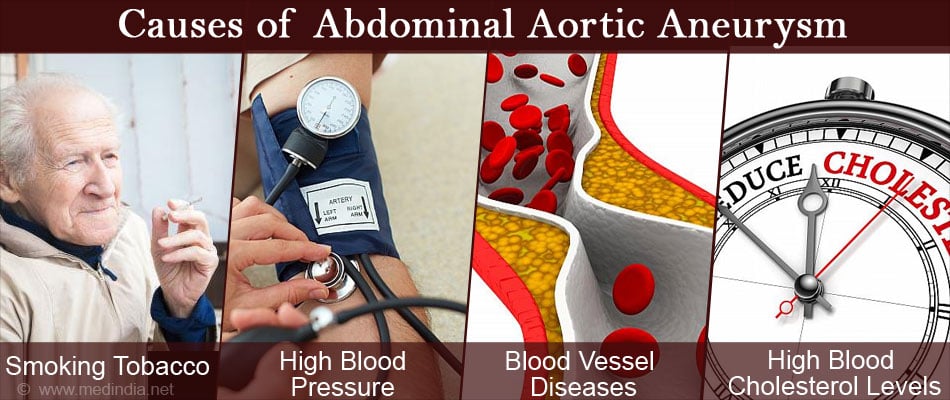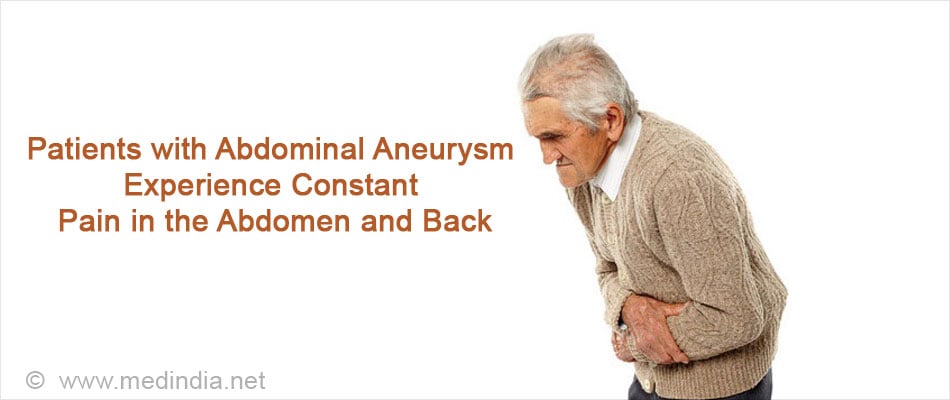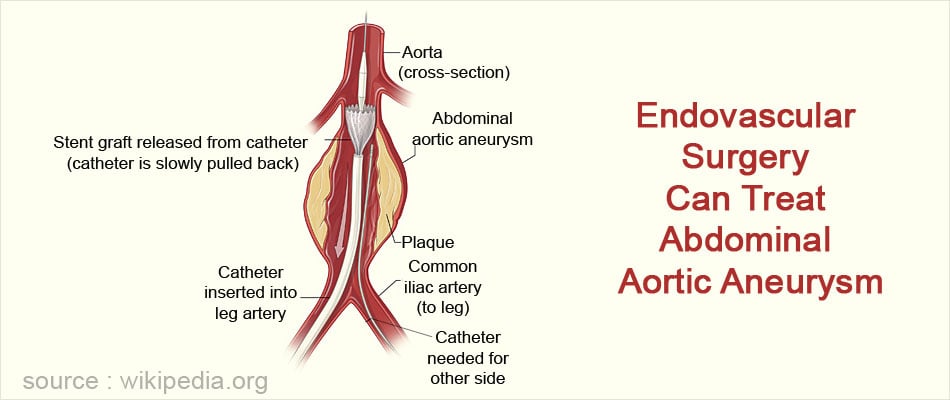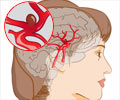- A N Assar and C K Zarins. Ruptured abdominal aortic aneurysm: a surgical emergency with many clinical presentations. Postgraduate Medical Journal 2009;85:268-273
- Abdominal aortic aneurysm - (http://www.mayoclinic.org/diseases-conditions/abdominal-aortic-aneurysm/home/ovc-20197858)
- What is Abdominal Aortic Aneurysm? - (https://vascular.org/patient-resources/vascular-conditions/abdominal-aortic-aneurysm)
- Learn About Abdominal aortic aneurysm - (https://medlineplus.gov/ency/article/000162.htm)
What is an Abdominal Aortic Aneurysm?
The abdominal aortic aneurysm is the dilatation and localized bulging of the abdominal part of the aorta owing to weakness of its wall.
The aorta is the main artery of the body that arises from the heart, passes down through the chest into the abdomen and supplies blood to the entire body through its branches. An abdominal aortic aneurysm occurs when the weakened area of the aortic wall in its abdominal part enlarges. It usually doesn’t cause any symptoms except back or abdominal pain, but can be life threatening if it ruptures.
Abdominal aortic aneurysm is the 10th most common cause of death in males older than 55 years in the United States. About 85% of abdominal aortic aneurysms are located below the origin of the renal arteries, the arteries that supply blood to the kidney.
Smoking is one of the most common and preventable risk factors of abdominal aortic aneurysms. Males between the ages of 65 and 75 years with a smoking history should undergo an ultrasound screening for abdominal aortic aneurysm as a preventive measure.
What are the Causes of Abdominal Aortic Aneurysms?
The exact cause of abdominal aortic aneurysm is not known. Certain predisposing factors increase an individual’s risk of developing the condition, which include the following:
- Tobacco Smoking - Smoking weakens the heart and aortic walls and also leads to atherosclerosis, which can result in abdominal aortic aneurysm
- High blood pressure – High blood pressure increases the risk of abdominal aortic aneurysm since it exerts pressure on the aortic walls and weakens them over a period of time
- Blood vessel diseases – Blood vessel diseases like Takayasu disease and giant cell arteritis cause inflammation and gradual weakening of aortic wall. Arteriosclerosis is a condition where the walls of the arteries harden and weaken, thereby predisposing to the formation of an aneurysm. Some bacterial and fungal infections of the aorta can also result in aneurysm
- Heredity – Abdominal aortic aneurysm runs in families
- Trauma to the abdomen
- Type 2 diabetes
- High blood cholesterol levels - The cholesterol can get deposited in the wall of the aorta, predisposing to aneurysm formation
- Age – Abdominal aortic aneurysms usually develop in people above 60 years of age
- Gender - Abdominal aortic aneurysm is more common in males as compared to females.
- Overweight
- Genetic conditions, namely Marfan syndrome and Ehlers-Danlos syndrome, which results in weakening of the aortic wall
Abdominal aortic aneurysms can be prevented to some extent by controlling smoking, and keeping a check on weight and blood pressure.

What are the Types of Abdominal Aortic Aneurysm?
Abdominal aortic aneurysms are classified according to their location with respect to the origin of the renal arteries from the aorta, the pair of arteries that supply blood to the kidneys, into:
- Infrarenal – The abdominal aortic aneurysm is located in that part of abdominal aorta which is just below the origin of the renal arteries. This is the most common type of abdominal aortic aneurysm
- Juxtarenal – The abdominal aortic aneurysm is located below the origin of the renal arteries but extends up to the renal arteries
- Suprarenal – The abdominal aortic aneurysm is located above level of renal arteries
Another classification is based on the thickness of blood vessels affected:
- True abdominal aortic aneurysm- This involves all three layers of the wall of the aorta
- False Aneurysm or pseudoaneurysm - A false aneurysm does not involve all the layers of the wall of the aorta
What are the Symptoms of Abdominal Aneurysm?
Abdominal aortic aneurysms usually do not produce any symptoms. As a result, early detection of the same is difficult. Therefore an abdominal screening is important if an individual falls under the high-risk category. The patient might report pain in the abdomen or back radiating to the groin, buttocks, or legs. As the aneurysm enlarges, the patient might experience a pulsating feeling near the navel and constant pain in the abdomen and back. The patient might complain of nausea, vomiting, increased urination and early satiety arising out of increased pressure of the bulge on adjacent body structures.

What are the Complications of Abdominal Aortic Aneurysms?
Complications of abdominal aortic aneurysms include the following:
- Formation of blood clots - Blood stagnates in the aneurysm thereby forming clots. A blood clot can block the blood flow in the abdominal aorta resulting in acute aortic occlusion. Small blood clots can break off and lodge in arteries in different parts of the body resulting in complications like stroke or heart attack.
- Rupture of the aneurysm following gradual enlargement - Rupture results in a sharp radiating pain in the abdomen and back with a feeling of a pulsatile abdominal mass. Other symptoms of rupture may include the following:
- Sweating
- Weakness
- Shortness of breath
- Increase in heart rate
- Unconsciousness
Such cases require emergency surgery to prevent further internal bleeding and related complications. If not immediately treated, the patient might land up in frank shock and sudden cardiovascular collapse. The death rate is almost 90% within minutes of rupture. Around 65% to 75% die before receiving medical help. The risk of rupture is more for larger aneurysms.
- Aortocaval fistula - It is the rupture of the aneurysm into the inferior vena cava, the main vein that drains blood from the lower part of the body, resulting in symptoms of heart failure. Sometimes, the rupture results in an aorto – left renal vein fistula, though it is extremely rare. It causes symptoms of abdominal pain, blood in urine, left kidney dysfunction and heart failure.
How is an Abdominal Aortic Aneurysm Diagnosed?
Usually, an abdominal aortic aneurysm is diagnosed during a routine physical or ultrasound examination while undergoing preventive health check-up or during an examination for any other reason. Once suspected, the doctor will review patient’s medical and family history. This will be followed by a physical examination and specialized tests to confirm the presence of the aneurysm. These tests include:
- Abdominal ultrasound - This test is the first choice when the patient complains of abdominal pain or the doctor suspects any pulsating abdominal mass. It helps in confirming the presence of an aneurysm in the abdominal area.

- CT scan – This test helps detect the size and shape of the aneurysm. The doctor might further advise CT angiography by injecting a dye to obtain details of the aneurysm.
- Magnetic resonance imaging (MRI) - An MRI or MRA (magnetic resonance angiography) is used to determine size and location of aneurysm. This diagnostic technique uses a magnetic field and pulses of radio wave energy to capture images of the aneurysm.
How is an Abdominal Aortic Aneurysm Treated?
The primary goal of treatment is to prevent the aneurysm from rupturing. The line of treatment, whether medical monitoring or surgery, is decided by the medical practitioner depending upon the size of the aortic aneurysm and its pace of growth.
Medical monitoring – Medical monitoring involves regular check-ups for aneurysms less than 4.5 cm to keep a check on its growth, and management of other medical conditions like high blood pressure, diabetes and high cholesterol levels that can lead to the growth and worsening of the aneurysm. Smokers with aneurysms should be asked to stop smoking.
- Surgery - If the size of abdominal aortic aneurysm is around 5 cm or more, fast growing or painful, surgery is recommended. Surgical options include:
- Open abdominal surgery - In this, the damaged section of the aorta is removed and replaced with a graft. Recovery takes longer than endovascular surgery.
- Endovascular surgery – It is a minimal invasive surgery and procedure of choice for abdominal aortic artery repair. A small incision is made in the upper thigh and a catheter with a synthetic graft is inserted through the artery in the groin. This graft supports the weaker section of the aorta and prevents further dilatation of artery and rupture of aneurysm. A camera mounted on the catheter allows the doctor to visualize the internal movement of the catheter.











